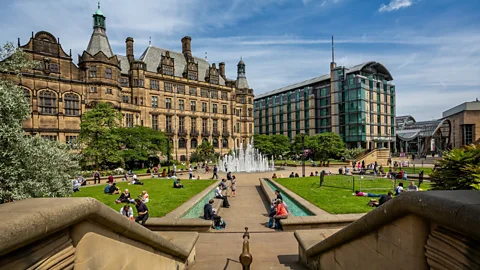ADS
Popular TikTok videos showed researchers entering Paris’ ancient catacombs, where six million dead are buried in pitch-black tunnels.
This morbid pastime involves sneaking in via illegal gates, walking across human bone-covered floors, crawling into femur-filled niches, and occasionally getting lost in the city’s 300km of off-limits corridors with headlamps. Parisian TikTok users have warned of the dangers, but the practice feeds a traveler’s ancient need to meet the dead.
The National Museum of Egyptian Civilization in Cairo attracts about one million people a year to witness Ramses II and Queen Nefertiti’s embalmed mummies in their coffins. Chairman Mao Zedong, Ho Chi Minh, and Vladmir Lenin’s embalmed corpses are seen by thousands in their Beijing, Hanoi, and Moscow mausoleums. In Philadelphia, one of the remaining 19th-century medical museums, the Mütter Museum displays Albert Einstein’s brain, President Grover Cleveland’s jaw tumor, conjoined stillborn twins, and rows of Victorian skulls to 135,000 tourists a year.
“Western society has a fascination with the macabre,” said Dr. Michael Pickering, associate professor in the Department of Heritage and Museum Studies at the Australian National University in Canberra and researcher on human remains display issues for 30 years. First Worlders are protected from death, thus horror excites us. An adrenaline rush.”
Displaying bodily parts has become unethical in recent years. New York’s American Museum of Natural History (AMNH) director Sean M. Decatur said in October 2023 that the last human remains would be taken from exhibit. The museum argued many were “victims of violent tragedies or representatives of groups who were abused and exploited, and the act of public exhibition extends that exploitation” . Handling leftovers as objects without authorization degraded them.
From Central Park, the skeleton of a 1,000-year-old Mongolian warrior in a renovated burial place and a 19th-century Tibetan apron made from human bones are gone.
Critics believe censoring such shows deprives the people of education. Mütter and other institutions are struggling. Can we learn from human remains, or do museums profit from tomb-raiders and body-traffickers?
First tourism sites worldwide
Travelers have always liked human remains. Christians traveled across Europe for months to see John the Baptist’s severed head (now in Rome’s Basilica of San Silvestro in Capite), St. Mary of Egypt’s tongue (in Vodnjan, Croatia’s Church of St. Blaise), and Jesus’ “holy foreskin” (the only piece of his flesh left after his ascension into Half a dozen European religions claimed this relic rescued after Christ’s circumcision. Ancient relics influenced early tourist sites. Body parts were profitable. The Catholic Church built expensive reliquaries and ran a hotel around them, charging wealthy tourists.
Modern exhibits featured celebrities, not saints. Romanticism motivated early 1800s travelers to find “secular relics”. Like Shelley’s heart and Beethoven’s ear bones, artists’ bodies seemed to connect them to their near-divine skills. The Florence History of Science Museum has Galileo’s middle finger in an egg-shaped glass ball.
Napoleon’s penis, allegedly removed by a vengeful Italian doctor during his 1821 autopsy, is my favorite celebrity relic. John Kingsley Lattimer, America’s best urologist, acquired the emperor’s member in 1977 and kept it under his bed in Englewood, New Jersey, for decades. The family showed it to few serious academics a decade ago, including myself.
Science allowed museums in Europe and the US to gather and exhibit the dead, especially Indigenous people from distant locations, in the 19th century. Victorian national institutions spent billions on archaeological expeditions to find ancient burial places in China, Alaska, and Peru.
Even worse, anthropology departments sent teams to “harvest” Indigenous bones from Texas to Tasmania, pillage burial sites or murder sites, or acquire them from “bone collectors”.
Phrenology, a strange “pseudoscience” that believed skulls could indicate racial traits like intelligence and industriousness, was first promoted. After Charles Darwin published The Origin of the Species in 1859, misguided Darwinists used phrenology to “prove” Indigenous people were less developed than Anglo-Saxons and justify imperial conquest. Western museum curators sold Indigenous bones like baseball cards to exhibit all “racial types”. Dakota Sioux, Namibian Herero, and Japanese Hokkaido skulls were sought by all curators.

Why is human depiction controversial?
Not everyone in the West believed displaying the dead was moral. Some Victorians fretted about crowds seeing Egyptian mummies, while others considered Egyptologists as grave-robbers.
Only recently have museum ethical concerns concerning exhuming, studying, and showing human remains shifted. Indigenous communities want their ancestors’ bones recovered from museums, triggering this reappraisal.
Native American activists in the US have requested museum improvements for decades. Artist, museology researcher, and Turtle Mountain Anishinaabe from North Dakota Hillary Kempenich said, “What gives scientists, archaeologists, and anthropologists the right to go into burial grounds and take what they want?” Kempenich found her tribe’s bones in boxes at the University of North Dakota in North Fork as a 10-year-old.
She said, “I was horrified,” since such exposure breaches Native American spirituality. “People may no longer be here to use their bodies, but we should still be respectful of them.”
The Smithsonian in Washington DC, the Hume-Carnegie Museum in Chicago, the Pitt Rivers Museum in Oxford, the Manchester Museum, and the South Australian Museum in Adelaide have withdrawn Indigenous body part exhibits.
“It’s an attempt to reconcile with our colonial past,” said former Canberra National Museum of Australia curator Pickering. Others matter if our remnants do. No first- or second-class remains.”
Pickering noted that every major Western anthropology museum, from the British Museum in London to the Museum of Mankind in Paris to the National Museum of the American Indian in Washington DC, stored Indigenous “harvested” bones into the 20th century. The AMNH has repatriated 1,000 Native American remains to their families under NAGPRA since 1990, yet it still has 2,200 bones.
ProPublica estimated 110,000 Native American, Hawaiian, and Alaskan remains in US museums, institutions, and government agencies in 2023. About 500,000 Indigenous people from throughout the world may live in US museums. Multiple that by overseas museums and the statistics are astounding.
NAGPRA has been painfully sluggish in repatriating US Native Americans’ remains. Over 30 years after the statute was passed, those at the University of North Dakota were moved in 2022.Since the statute requires a “cultural affiliation” with the past, bureaucratic inertia, insufficient museum archives, and (according to many curators) the difficulty of locating descendants of the brutally destroyed Native peoples have hindered the process.
A compliance circumvention problem, according to Kempenich.In the end, museums must consult families and communities. She said be tactful. Kempenich considers human remains recovery merely one part. She and other activists feel Native Americans should be compensated for the abuse that led to burial site pillage. 12–15% of my neighborhood is Native American. How are decades of wickedness corrected?”
To make matters worse, NAGPRA only handles Native American remains. US museums may do what they want with their African, Oceanian, Asian, and Latin American collections since no law mandates them to return Indigenous remains. US museums usually wait until pressed due to understaffing and underfunding. The Smithsonian Institution returned the remains of Aboriginal Gunbalanya community members taken without authorization in 1948 to Australia in 2022, four years after the Australian government exercised diplomatic pressure.
Entertainment vs. learning
A recent ethical reappraisal of Indigenous human remains has expanded to all human relics. The Mütter Museum became a case study in 2022 when new executive director Kate Quinn deemed certain anatomical exhibits unethical, regardless of Indigenous provenance. Quinn said that certain European and American bodies had been donated to the museum for medical study, but some of its most popular exhibitions had not.
At 1873, the “Soap Lady” Mrs. Ellenbogen was illegally dug up at a cemetery, her fatty tissue having degraded to almost mummification. Quinn said Philadelphia’s Academy of Natural Sciences curator Joseph Leidy lied about Ellenbogen being his grandmother to the gravedigger. In 1873, Austrian phrenologist Josef Hyrtl abducted skulls from impoverished Eastern Europeans and sold them to the Mütter. According to the notes, “Although collecting skulls was legal in Hyrtl’s time, the practice was discriminatory, non-consensual, and degrading.” Displays at the Mütter Museum remain popular.
In June 2023, the Wall Street Journal’s “Cancel Culture Comes for Philly’s Weirdest Museum” accused the Mütter of satisfying “woke elite” and enraged conservatives. Thirteen staff members departed in Quinn’s first nine months over “the deconstruction of the museum”; a petition to reject the changes garnered 21,000 signatures in two weeks.
Researchers uncovered rare historical DNA samples, damaged tissue, and cholera victims’ bones in the Mütter’s anatomical displays, which some considered therapeutic. War crime investigators examined Hyrtl skulls in 1990s Balkan mass graves. Critics argue this study can be done without showing them. “Why are the weirdest deformities and curiosities still being exhibited?” Pickering queries.”Why are the craniums laid out like Aztec skull racks?”
Pickering suggests fun: “Global museums are struggling. People must be drawn. They become entertainment palaces. Education is no longer their goal.”
The ethical dilemma in museums will persist as curators globally treat human material carelessly. Egyptian mummies are profitable, but TikTokers will explore Paris’ catacombs regardless of their mood.
Living people seem drawn to the dead.





